 Lights! Camera! Sound! Production! Actors! Action!
Lights! Camera! Sound! Production! Actors! Action!
We’ve all watched a film and thought to ourselves: “Even I could make this more cohesive than the professionals.” All it takes is some cinematic know-how, a friend who can spin a good yarn, and maybe some special effects sprinkled in to cover your bases.
Roll Camera is a cooperative dice placement filmmaking game from designer Malachi Ray Rempen and Keen Bean Studio. It plays from one to four players in about an hour. It’s all about utilizing available resources to keep your production afloat. And maybe, just maybe, you’ll create a visual feast for the ages. Well, if you keep the continual production problems at bay.
Gameplay Overview:
Players begin by selecting their player board and difficulty level. Difficulty level determines both the starting budget as well as the schedule timeline. The budget is used to pay for shooting scenes and each round the schedule advances one step. Players have a shared goal of filming five scenes before either one of these resources runs out. Otherwise, the production is halted, and it is game over.
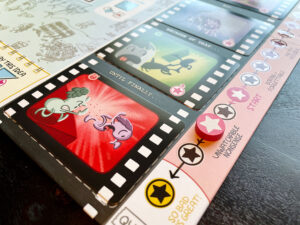
Turns feature five steps. The first is to reveal a problem card. These production problems range in variety and usually provide an elevated challenge. There can be up to three in play at one time. After this, players roll and place the six crew dice. Each die has the chance to be a camera, lighting, sound, actors, art department, or the wildcard, visual effects.
Crew can be assigned to several areas. They can be utilized to solve production issues, to build or rearrange a central set area, gain an intern (and another problem), as well as propose ideas during a production meeting. There are also placement spaces for activating an approved idea at the cost of budget or production quality. Beyond the main board, players’ individual boards also feature actions specific to their role on set. For example, the producer can cut corners by gaining money (and problems) while the editor can rearrange scene cards.
Three storyboard cards are displayed on the main board and indicate their requirements, which involve a specific placement of crew on top of set pieces to shoot the scene. It may take multiple rounds to get the scene set up, and this can lock up dice for the next player unless they decide to rearrange the board on their turn. There is also a script section of the main board that features an upper and lower deck, each with a portion of the film’s title and end game conditions based on the type of scenes that were shot.
All of this is in service of raising the quality of the production. Certain set pieces, scenes, and ideas can all raise the quality from forgettable to critical darling. Alternatively, the game can also be won with the quality track at rock bottom—so bad it’s great! Anything that falls within the red zone signals a loss even if all five scenes are completed.
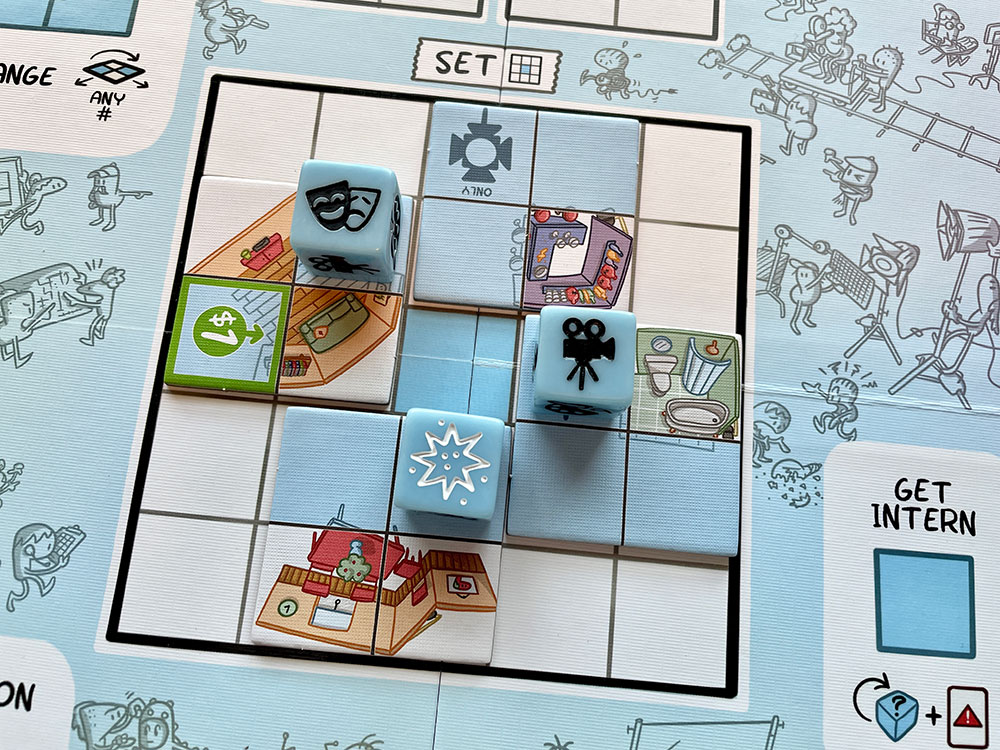
Game Experience:
That’s about all there is to it. The meat of the game is the dice placement decisions that need to be made with an ever-dwindling budget, schedule, and increase in problems. As such, players juggle their options to try and get something filmed. Roll Camera has a thematic flair to it in this regard—the horrifying tales of Hollywood elites and the events that shape and destroy cinematic endeavors.
It’s trying very hard too. There are “player privileges” on each role board that add a party vibe. Yet, they don’t really do anything to add to the game (the cinematographer can choose the game room’s lighting for instance). The same is apparent in the rulebook with suggestions to grab some popcorn and act out your movie in the end, though the five scenes you create take only moments to rehash and don’t provide true entertainment. An editor would’ve left these on the cutting room floor in favor of better gameplay elements.
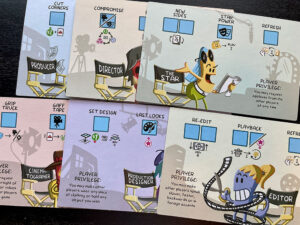
The rulebook also has suggestions to make sure that players are being included even when it’s not their turn. The production meeting dice placement tries to add some co-op flavor to each turn if utilized, but there’s not enough inherent in the design to keep people engrossed in each turn. And while players can freely talk about working toward a common goal, once dice are locked into spaces for the next player to try and roll the correct crew, options become scarcer. Player A started to build this set, so Player B falls in line.
Roll Camera does have some interesting ideas. My favorites have to do with the thematic flourishes. The production problems are fun to imagine, even if all you really need to do is place some dice to remove them (they get harder to remove over time). The set pieces lack visual flair and even with the crew icons on the dice, you never truly feel like you’re putting a set together. But at an abstract level, it’s cute. Also, the thematic character roles are fun—each has two unique powers, and all share an idea refresh option.
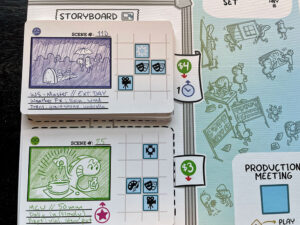
The stars of the show are such simple things: the budget/schedule dial and the already mentioned quality track. The dial has difficulty levels on the back that create your starting resources for you. It’s a clever way to consider your options without referring to the rulebook. And the quality track’s red zone does make decisions more tense. Plus, trying to tank the production to make the worst film ever is a great touch. Ed Wood is smiling at the thought.
Many things on display are luck-based though. You roll dice and have one way to mitigate the rolls by taking on an intern (which just allows you to flip a die to the face you’d prefer), but also adds a new problem card. Card draws have little consideration for choice, though this truly only happens with the storyboard cards as the script sees little movement and the idea cards are abundant enough. Regardless, there’s not much variety and placing dice into blanks spaces is not very exciting.
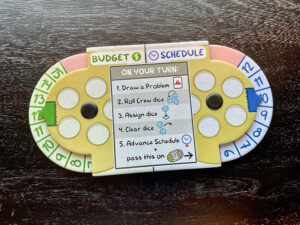
Even though it’s short on strategy, there is a game here. It’s just not as enthralling as I would’ve liked to see with all the ideas suggested. It reminds me a lot of The Networks, a game about running your own cable television network. It provides a fun initial buy-in as you learn the cards for the first time and work out the novel moments, but quickly loses steam. I prefer this as a solo or two-player game only. It does have enough tension in the resource restrictions to provide a little challenge. Though in the end you’re forced into choice based on your rolls.
A final note on production—the clapboard box and film canister insert are wonderful. The main board has some gloss elements (spot UV), and the rulebook and cards are all great quality. And while the illustration is whimsical, it’s also distracting. Coupled with a horrible font choice, it makes me wonder why there wasn’t more input on making this more presentable where it counts.
Final Thoughts:
As a cinephile, there were moments here that I enjoyed. I’m a sucker for dice and theme. Which is why I thought this would really hit the spot. Unfortunately, I didn’t provide enough depth to see this coming out on future game nights. I do know that there is a B-movie expansion that’s available for this, but in the description, it reads that “the whole thing is causing more disorganization and chaos than ever before…” So, I get it. Roll Camera is going for fun event style game. And if that sounds like a fun evening, then at least consider reading more about it over on BGG and get some input from the fans there.
Final Score: 2.5 stars – As the quality track may indicate, Roll Camera’s gameplay is “pretty mediocre,” but thankfully did not run into any production problems.
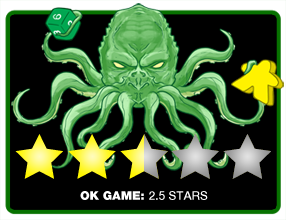 Hits:
Hits:
• Quality track options
• Juggling budget/schedule
• Production problems
Misses:
• Lackluster worker placement
• Shallow strategy
• Confusing interaction identity
• Minimal luck mitigation






















